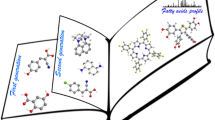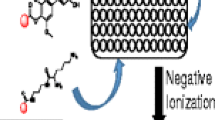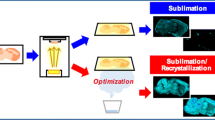Abstract
The great hurdles related with matrix-assisted laser desorption/ionization (MALDI) analysis are inhomogeneous crystallization, poor reproducibility, and low sensitivity. To effectively improve the performance of MALDI mass spectrometry (MS), graphene oxide (GO) was first utilized as an auxiliary matrix of the conventional matrices, including 2,5-dihydroxybenzoic acid (DHB), α-cyano-4-hydoxycyanocinnamic acid (CHCA), 2,4,6-trihydroxyacetophenone (THAP), and 3,5-dimethoxy-4-hydroxycinnamic acid (SA), for the analysis of small molecules and biological macromolecules on different MALDI MS systems. The results revealed that the DHB-GO composite matrix could provide much superior crystal homogenization, better reproducibility, higher sensitivity, and more excellent linearity for the statins’ tissue imaging on iMScope than the single-use DHB matrix. Moreover, the DHB-GO dramatically improved the spot-to-spot and shot-to-shot reproducibility, crystal homogenization, sensitivity, and linearity of MALDI-TOF MS for statins’ analysis in dried droplet. The capability of THAP on the analysis of lipids, similarly, could be greatly enhanced by the combined use of GO. THAP-GO composite matrix was expected to be widely used in the MALDI MS-based liposome studies. It was also found that CHCA-GO could provide superior analytical performance for peptides. The sensitivity and reproducibility of intact proteins could be greatly improved by SA-GO composite matrix. More importantly, the better reproducibility produced by the composite matrices sufficiently indicated that low concentration (0.1 mg mL−1) of GO almost did not cause contamination to MALDI MS system. Thus, GO was proved to be a versatile auxiliary matrix for the MALDI MS-based routine analysis of small molecules and biological macromolecules.

ᅟ







Similar content being viewed by others
References
Wang J, Liu Q, Liang Y, Jiang G. Recent progress in application of carbon nanomaterials in laser desorption/ionization mass spectrometry. Anal Bioanal Chem. 2016;408:2861–73.
Karas M, Hillenkamp F. Laser desorption ionisation of proteins with molecular masses exceeding 10,000 Da. Anal Chem. 1988;60:2299–301.
Lacroix C, Gicquel A, Sendid B, Meyer J, Accoceberry I, François N, et al. Evaluation of two matrix-assisted laser desorption ionization-time of flight mass spectrometry (MALDI-TOF MS) systems for the identification of Candida species. Clin Microbiol Infect. 2014;20:153–8.
Köhler M, Neff C, Perez C, Brunner C, Pardon E, Steyaert J, et al. Binding specificities of nanobody membrane protein complexes obtained from chemical cross-linking and high-mass MALDI mass spectrometry. Anal Chem. 2018;90:5308–13.
Zhang J, Zheng X, Ni Y. Selective enrichment and MALDI-TOF MS analysis of small molecule compounds with vicinal diols by boric acid-functionalized graphene oxide. J Am Soc Mass Spectrom. 2015;26:1291–8.
O’Rourke MB, Djordjevic SP, Padula MP. The quest for improved reproducibility in MALDI mass spectrometry. Mass Spectrom Rev. 2016;37:217–28.
Shi C, Meng J, Deng C. Enrichment and detection of small molecules using magnetic graphene as an adsorbent and a novel matrix of MALDI-TOF-MS. Chem Commun. 2012;48:2418–120.
Toh-Boyo GM, Wulff SS, Basile F. Comparison of sample preparation methods and evaluation of intra- and intersample reproducibility in bacteria MALDI-MS profiling. Anal Chem. 2012;84:9971–80.
Šedo O, I S, Z Z. Sample preparation methods for MALDI-MS profiling of bacteria. Mass Spectrom Rev. 2011;30:417–34.
Zhao X, Barbersingh J, Shippy SA. MALDI-TOF MS detection of dilute, volume-limited peptide samples with physiological salt levels. Analyst. 2004;129:817–22.
Acland M, Mittal P, Lokman NA, Klinglerhoffmann M, Oehler MK, Hoffmann P. Mass spectrometry analyses of multicellular tumour spheroids. Proteomics Clin Appl. 2018;12:e1700124.
Gerald Stübiger A, Belgacem‡ O. Analysis of lipids using 2,4,6-trihydroxyacetophenone as a matrix for MALDI mass spectrometry. Anal Chem. 2007;79:3206–13.
Sun N, Wu Y, Nanba K, Sbiera S, Kircher S, Kunzke T, et al. High-resolution tissue mass spectrometry imaging reveals a refined functional anatomy of the human adult adrenal gland. Endocrinology. 2018;159:1511–24.
Rodrigo MA, Zitka O, Krizkova S, Moulick A, Adam V, Kizek R. MALDI-TOF MS as evolving cancer diagnostic tool: a review. J Pharm Biomed Anal. 2014;95:245–55.
Chughtai K, Heeren RM. Mass spectrometric imaging for biomedical tissue analysis. Chem Rev. 2010;110:3237–77.
Shimma S, Kumada HO, Taniguchi H, Konno A, Yao I, Furuta K, et al. Microscopic visualization of testosterone in mouse testis by use of imaging mass spectrometry. Anal Bioanal Chem. 2016;408:7607–15.
Harada T, Yubakubo A, Sugiura Y, Zaima N, Hayasaka T, Gotoinoue N, et al. Visualization of volatile substances in different organelles with an atmospheric-pressure mass microscope. Anal Chem. 2009;81:9153–7.
Kurabe N, Igarashi H, Ohnishi I, Tajima S, Inoue Y, Takahashi Y, et al. Visualization of sphingolipids and phospholipids in the fundic gland mucosa of human stomach using imaging mass spectrometry. World J Gastrointes Pathophysiol. 2016;7:235–41.
Fukuyama Y. MALDI matrix research for biopolymers. Mass Spectrometry. 2015;4:A0037.
Li F, Wang X, Liu Y, Liu H, Li Z. Dephosphorylation of intact glycoprotein to greatly improve digestion efficiency coupled with matrix-assisted laser desorption/ionization-Fourier transform ion cyclotron resonance mass spectrometric analysis. Anal Chim Acta. 2013;787:140–7.
Largy E, Cantais F, Van VG, Beck A, Delobel A. Orthogonal liquid chromatography-mass spectrometry methods for the comprehensive characterization of therapeutic glycoproteins, from released glycans to intact protein level. J Chromatogr A. 2017;1498:128–46.
Wei Y, Zhang Y, Lin Y, Li L, Liu J, Wang Z, et al. A uniform 2,5-dihydroxybenzoic acid layer as a matrix for MALDI-FTICR MS-based lipidomics. Analyst. 2015;140:1298–305.
Malys BJ, Owens KG. Improving the analyte ion signal in matrix assisted laser desorption ionization imaging mass spectrometry via electrospray deposition by enhancing incorporation of the analyte in the matrix. Rapid Commun Mass Spectrom. 2017;31:804–12.
Doktycz SJ, Savickas PJ, Krueger DA. Matrix/sample interactions in ultraviolet laser-desorption of proteins. Rapid Commun Mass Spectrom. 1991;5:145–8.
Chan TWD, Colburn AW, Derrick PJ, Gardiner DJ, Bowden M. Suppression of matrix ions in ultraviolet laser desorption: scanning electron microscopy and Raman spectroscopy of the solid samples. J Mass Spectrom. 1992;27:188–94.
Cai YH, Wang YS. Impact of uneven sample morphology on mass resolving power in linear MALDI-TOF mass spectrometry: a comprehensive theoretical investigation. J Mass Spectrom. 2018;53:361–8.
Strupat K, Karas M, Hillenkamp F. 2,5-Dihydroxybenzoic acid: a new matrix for laser desorption—ionization mass spectrometry. Int J Mass Spectrom. 1991;111:89–102.
Liu Q, Shi J, Jiang G. Application of graphene in analytical sample preparation. Trends Analyt Chem. 2012;37:1–11.
Liang X, Liu S, Wang S, Guo Y, Jiang S. Carbon-based sorbents: carbon nanotubes. J Chromatogr A. 2014;1357:53–67.
Zhang BT, Zheng X, Li HF, Lin JM. Application of carbon-based nanomaterials in sample preparation: a review. Anal Chim Acta. 2013;784:1–17.
Sunner J, Dratz E, Chen YC. Graphite surface-assisted laser desorption/ionization time-of-flight mass spectrometry of peptides and proteins from liquid solutions. Anal Chem. 1995;67:4335–42.
Chang C, Li X, Bai Y, Xu G, Feng B, Liao Y, et al. Graphene matrix for signal enhancement in ambient plasma assisted laser desorption ionization mass spectrometry. Talanta. 2013;114:54–9.
Dale MJ, Knochenmuss R, Zenobi R. Graphite/liquid mixed matrices for laser desorption/ionization mass spectrometry. Anal Chem. 1996;68:3321–9.
Wang Z, Cai Y, Wang Y, Zhou X, Zhang Y, Lu H. Improved MALDI imaging MS analysis of phospholipids using graphene oxide as new matrix. Sci Rep. 2017;7:44466.
Gorka J, Bahr U, Karas M. Graphite supported preparation (GSP) of α-cyano-4-hydroxycinnamic acid (CHCA) for matrix-assisted laser desorption/ionization mass spectrometry (MALDI-MS) for peptides and proteins. J Am Soc for Mass Spectrom. 2012;23:1949–54.
Li X, Rao T, Xu Y, Hu K, Zhu Z, Li H, et al. Pharmacokinetic and pharmacodynamic evidence for developing an oral formulation of octreotide against gastric mucosal injury. Acta Pharmacol Sin. 2018;39(8):1373–85.
Rao T, Shao Y, Hamada N, Li Y, Ye H, Kang D, et al. Pharmacokinetic study based on a matrix-assisted laser desorption/ionization quadrupole ion trap time-of-flight imaging mass microscope combined with a novel relative exposure approach: a case of octreotide in mouse target tissues. Anal Chim Acta. 2017;952:71–80.
Beavis RC, Chait BT, Fales HM. Cinnamic acid derivatives as matrices for ultraviolet laser desorption mass spectrometry of proteins. Rapid Commun Mass Spectrom. 1989;3(12):432–35.
Kudina O, Eral B, Mugele F. e-MALDI: an electrowetting-enhanced drop drying method for MALDI mass spectrometry. Anal Chem. 2016;88(9):4669–75.
Vorm O, Roepstorff P, Mann M. Improved resolution and very high sensitivity in MALDI TOF of matrix surfaces made by fast evaporation. Anal Chem. 2002;66(19):3281–87.
Li X, Xu G, Zhang H, Liu S, Niu H, Peng J, et al. A homogeneous carbon nanosphere film-spot: for highly efficient laser desorption/ionization of small biomolecules. Carbon. 2017;121:343–52.
Shi R, Dai X, Li W, Lu F, Liu Y, Qu H, et al. Hydroxyl-group-dominated graphite dots reshape laser desorption/ionization mass spectrometry for small biomolecular analysis and imaging. ACS Nano. 2017;11(9):9500–13.
Funding
This study was supported by the National Nature Science Foundation (81573559, 81530098), the Nature Science Foundation of Jiangsu Province (BK20171395), and the National Key Special Project of Science and Technology for Innovation Drugs of China (2017ZX09301013).
Author information
Authors and Affiliations
Contributions
All authors have given approval to the final version of the manuscript.
Corresponding authors
Ethics declarations
All the animal experiments in the present study were approved by the Ethical Committee of Animal Experiments of China Pharmaceutical University.
Conflict of interest
The authors declare that they have no conflict of interest.
Additional information
Publisher’s note
Springer Nature remains neutral with regard to jurisdictional claims in published maps and institutional affiliations.
Electronic supplementary material
ESM 1
(PDF 166 kb)
Rights and permissions
About this article
Cite this article
Zhu, Z., Shen, J., Wang, D. et al. An auxiliary matrix for routine analysis of small molecules and biological macromolecules using matrix-assisted laser desorption ionization mass spectrometry. Anal Bioanal Chem 411, 1041–1052 (2019). https://doi.org/10.1007/s00216-018-1532-6
Received:
Revised:
Accepted:
Published:
Issue Date:
DOI: https://doi.org/10.1007/s00216-018-1532-6




